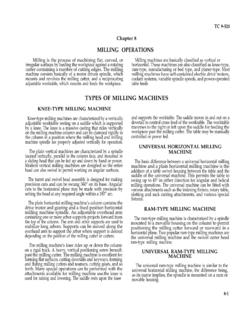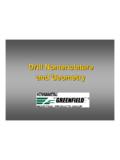Transcription of An Idiot's Guide to Rebuilding the 8520 head
1 An Idiot's Guide to Rebuilding the 8520 head. Background:I bought my Clausing 8520 in October 2002 after looking semi-seriously for about a year. Most of the E-bay deals were well over $1000 so when I was able to get mine for $700 I was delighted. It looked to be inpretty good shape, but had a 3-phase motor without a handy power source where I bought it. So other thanspinning the spindle by hand I couldn't really judge the condition of the rotating forward a month during which time I cleaned up and painted the mill and did a few obvious minorrepairs. After giving up on finding a good cheap VFD, I got a new single phase 3/4 hp 56C frame motor onEbay for $25 (that morphed into ~$70 by the time I got it shipped to me and got a proper base welded on).
2 Ispent a little bit of time figuring out how to adapt the 3 phase switch to a single phase motor (another write-up) and then finally fired up the mill in late November. While quiet at 180 rpm, it got steadily louder as Iincreased speed, getting pretty unpleasant by 1900 and sounding like a freight train clattering through myshop at the 3250 rpm full I took off the belts, spun the spindle pulley by hand again and now noticed some roughness in therotation. Either I hadn't observed this carefully during my initial inspection or else just my few second ofrunning the machine at high speed had dislodged some old crap inside the spindle. Regardless, it was clearthat I needed to take the head apart and at least look at the spindle , I 'd been reading the Clausing group on Yahoo and was inspired by Dennis Pantazis' write-upof his own head Rebuilding experiences.
3 I had no experience whatsoever in machine tool Rebuilding , but I'dbeen a gearhead for many years and had engines and trannies (and their various parts) out of my cars manytimes and figured that it didn't look all that hard. Ultimately, in fact, it wasn't all that hard. But there wereseveral problems I encountered during the process that were outside my experience and not described inDennis' text. I spent several weeks bothering many folks on the Clausing group trying to figure out how toproceed through these problems and wanted to summarize what I found out so that others might have aneasier time of it. Step by step Illustrated Guide :This is a more detailed version of Dennis Pantazis' write-up on 8520 head Rebuilding .
4 It will be redundantfor experienced machinists, but it may save some time for other hobbyists as clueless as I .Note: All parts names will be as given in the Clausing Head Assembly Diagram from the 8520 manual andwill be identified by their part Tools:1. Set of Allen wrenches (3/32" to 3/16")2. Flat blade screwdrivers (large and small)3. 2 or 3 jaw puller (can be gotten for $10 - $20 from your local auto parts store)4. Snap ring pliers5. Adjustable pin spanner wrench with 1/8" pins (these can be bought from tool supply houses, but mostlocal stores seem to only have the kind with the more common 4 mm pins. I bought one of the 4 mmkind and modified it. Or you can just build one from scratch as Dennis Pantazis describes in his write-up)6.
5 Hammer (any will do, I used a 10 lb. sledge)7. Bench vise8. Some 2x4's9. Plenty of clean rags. part I: Spindle and Bearing RemovalThese first few tasks were easiest for me with the head in its standard vertical Remove drive belt from front pulley (560-009).2. Remove drawbar from Unscrew 4 screws attaching head guard (342-020) to head housing (386-020) and remove guard byslowly sliding forward. You can remove the brake shaft and handle (8520-15) first if you wish, butletting brake handle and brake band rotate, I was able to slide the guard off with the brake handleattached. 4. Use an Allen wrench to remove the two 1/4-20 cap screws from the drive plate (556-020) and a smallflat blade screwdriver to loosen the two setscrews on the sides of the drive plate.
6 Don't completelyremove these setscrews as they hold in tiny springs that can be hard to find after they fall out. Nowslide the drive plate up and off the splined shaft. My drive plate came off easily enough withoutbinding anywhere, but if your splines have been damaged it may stick. (Note that the belt is still on inthese two pictures only because I went back to take them after finishing the job) 5. Use snap ring pliers to remove the retainer (641-011) from the collar on top of the pulley (560-009).This can be done with ordinary needle nose pliers but is much, much easier with the right tool -available for <$5 from your local discount tool store. 6. Use puller to remove pulley (560-009) from the spindle. You are sliding the inner hub of the pulleyoff of a bearing (044-007) and it should come off pretty easily.
7 I tried Dennis' trick of using ahammer for this job and didn't have much luck. A puller provides steady centered for and workedmuch better for me. 7. Use an Allen wrench to remove the three cap screws from the pulley sleeve assembly (990-061), andlift it off the spindle. The pulley sleeve assembly has a bearing attached to its shaft that I neverremoved, as it was still in good condition. 8. Remove brake band (which Clausing cryptically refers to as Plate Assembly (8520-10). It should liftoff freely from the head housing. Now the top spindle bearing (044-016) should be visible in the top of the quill (631-003). At thispoint you have two choices. You can either remove the quill from the head housing and work on itseparately from the mill, or you can leave it in.)
8 Since I don't have any good methods of holding largepieces without marring them in my shop, I chose to leave the quill in the head housing. 9. Since you are now likely to subject the quill to some healthy forces, it's a good idea to remove thevertical feed assembly (the four gears and two knobs attached to housing (386-009) in the headdiagram).10. Rotate the head on the ram about 90 degrees and tighten it back down. This is to get easier access tothe bottom of the If necessary build an adjustable pin spanner with 1/8" pins. I did this by taking a store boughtadjustable pin spanner with 4 mm pins, drilling a 1/8" hole in each arm near the pins and inserting1/8" drill bits. The base of the bits sticking out the back side of the wrench now served as the pins ofan 1/8" pin Put the pins of the pin spanner wrench in the two holes in the retainer (641-008) in the bottom of thequill surrounding the nose of the spindle.
9 Find and remove any retaining pins or setscrews near thebottom of the quill and then unscrew the retainer. I had no pins or setscrews holding in this retainer in my 1968 era 8520 while Dennis Pantazis did inhis 1955 machine. You will need to check yours carefully to be sure. It required a lot of force initiallyto unscrew my retainer (probably 100-150 lbs. applied by hand to the end of the pin spanner wrench).Be very careful that the arms of the pin spanner are flush with the face or the retainer. I was not andbroke one off in the retainer hole. I was able to drill this out, repeat with the pin spanner set properlyand get the retainer out, but not before trashing the face of the retainer enough that I chose to replaceit.
10 This is a $50 part from Clausing, so don't make this mistake. With the retainer out you will be looking into the quill at the bottom of the spindle bearing. The onlything now holding the spindle in the quill is friction between the quill and the outer races of the lowerspindle bearings and between the spindle and the inner race of the upper spindle bearings. The upperand lower bearings both sit in slightly larger sections of the quill. So the lower bearings can only goout through the bottom of the quill and the upper bearing only through the we now need to do is press the spindle along with the lower bearings out the bottom of thequill. The top spindle bearing will remain with the quill. This was the most difficult step in the wholeprocess for me.



